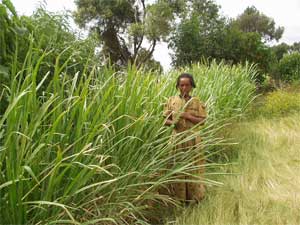BackgroundNapier or elephant grass (Pennisetum purpureum), together with its hybrids with Pennisetum glaucum, is one of the major forages used in zero-grazing systems in many parts of sub-Saharan Africa. It is a tall, perennial grass that is indigenous to tropical Africa, and performs well from sea level up to an altitude of 2000m. It can withstand repeated cutting and regrows rapidly, producing a high biomass that is very palatable in the leafy stage. Since pests and disease problems are rare, it can be made into silage for feeding to livestock during the dry season. When grown in conjunction with leguminous trees, the plant's total yield and nutritive value are increased. Besides its use as fodder Napier grass can also be used for soil regeneration and mulch. In some countries it is used for the manufacture of paper pulp. |
||
|
Napier grass has become a popular feed for livestock among smallholder farmers, because of its rapid growth, high nutritive value and yield, and ease of propagation, especially for dairy cattle, and especially in Kenya. |
 Source: ILRI |
|